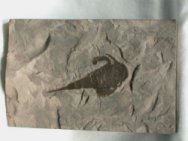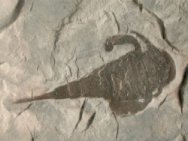Eurypterus
remipes
Merostomata,
Eurypterida, Eurypteridae
Geological
Time: Upper Silurian, (~410 m.y.a.)
Size: 60
mm long by 30 mm wide at the swimming legs
Fossil Site:
Bertie Group, Fiddler’s Green Formation, Phelps Waterlime, Herkimer
County, New York
 Description:
While Eurypterids (“Sea Scorpions”) are uncommon fossils
worldwide, New York state is one of the few places where conditions
for preservation have been ideal. They were large arthropod predators
during the Silurian and Devonian, reaching a maximum length of 2 meters.
The Eurypterid colonies of New York are distinctly localized, with
two being found above and two below the salt beds of what was termed
the Salina Series. These colonies are presumed to be breeding pools
of brackish to partly open basins. They are the Otisville Basin (Colony
O), the Pittsford Pool (Colony P), the Herkimer Pool (Colony P), and
the Buffalo Pool (Colony P). These last two are the most famous of
them, yielding numerous fantastic specimens. Erypterus remipes was
a small example of the Merostomata, with specimens having been found
ranging from 8 mm to 280 mm in length. It is presumed to have crawled
along the seafloor, using its grasping pincers to seize trilobites
and other prey. This fine example is a juvenile, and has the swimming
paddles and a pair of walking legs preserved. The segmentation of
the meso- and metasoma is well detailed, and the specimen is well-centered
on the dolostone matrix. This is a fine example of the fossil designated
the New York State Fossil by then Governor Mario Cuomo in 1984. Description:
While Eurypterids (“Sea Scorpions”) are uncommon fossils
worldwide, New York state is one of the few places where conditions
for preservation have been ideal. They were large arthropod predators
during the Silurian and Devonian, reaching a maximum length of 2 meters.
The Eurypterid colonies of New York are distinctly localized, with
two being found above and two below the salt beds of what was termed
the Salina Series. These colonies are presumed to be breeding pools
of brackish to partly open basins. They are the Otisville Basin (Colony
O), the Pittsford Pool (Colony P), the Herkimer Pool (Colony P), and
the Buffalo Pool (Colony P). These last two are the most famous of
them, yielding numerous fantastic specimens. Erypterus remipes was
a small example of the Merostomata, with specimens having been found
ranging from 8 mm to 280 mm in length. It is presumed to have crawled
along the seafloor, using its grasping pincers to seize trilobites
and other prey. This fine example is a juvenile, and has the swimming
paddles and a pair of walking legs preserved. The segmentation of
the meso- and metasoma is well detailed, and the specimen is well-centered
on the dolostone matrix. This is a fine example of the fossil designated
the New York State Fossil by then Governor Mario Cuomo in 1984. |
|



